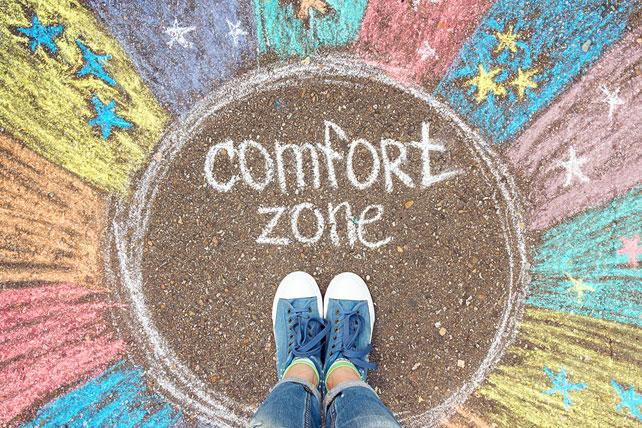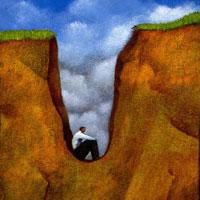
Comfort is the final thief of happiness in our series.
As a reminder, the Five Thieves of Happiness are five harmful thought patterns that prevent us from living a joyful life. These destructive patterns cause us to stand in the way of our happiness and prevent us from leading a fulfilled life.
Dr. Izzo, who coined the term “Five Thieves of Happiness,” argues that to find true joy, we need to learn how to identify and “lockout” these thieves by rebuilding our thought patterns and living a more thoughtful, compassionate, and happier life.
The Five Thieves of Happiness are control, conceit, comparison, consumption, and comfort. We’ve already introduced the first four of the Five Thieves of Happiness; you can read about them below:
Are You Getting Too Comfortable?
“Life begins at the end of your comfort zone.”
The vast majority of humans have become conditioned to expect a certain level of comfort everywhere we go. We’ve come to expect functioning A/C in the summer and heating in the winter. We often take for granted food, water, and shelter. We have running water, indoor plumbing, and a full fridge.
Outside of our creature comforts, we’ve also become comfortable in other ways: we develop routines, follow schedules, and our lives fall into a natural rhythm. For many, this can seem ideal, especially for those of us who grew up in less than stable environments. But in The Five Thieves of Happiness, Dr. Izzo argues that these comfortable routines reach a point where they no longer serve us. Instead, in many cases, they’re holding us back.
Concerns about the Comfort Zone

Have you ever felt like you were stuck in a rut? Like your wheels were spinning, but you weren’t quite getting anywhere? Dr. Izzo believes that spending too much time in your comfort zone can create a sense of idleness that will eventually make you feel like you’re stuck. If we spend our days on autopilot, we become emotionally numb. That constant numbness can eat away at our happiness.
Here are some common signs that you might be in a rut (and stuck in your comfort zone):
- You don’t look forward to anything anymore.
- You don’t have a creative spark about projects or hobbies that once excited you.
- Your days blur together.
- You want to try something new, but you don’t know where to start.
- You know you want to branch out, but you think it’s safer to stay in your comfort zone.
Humans are hardwired to develop routines, but at the same time, we’re all excited by change. This creates a natural tension — we all want to try new things, but many of us are risk-averse. We’re hesitant to jump into something new and leave behind the things that are familiar to us.
Dare to Disrupt Your Routines
There’s a reason we like comfort. It’s safe, it’s efficient, and it’s easy. But one of the primary sources of happiness is new experiences, which means that sometimes, we need to step outside of our comfort zones and try something new.
I’ll give you an example from my own life. I mentioned I’d taken a sabbatical from work in a past installment and decided to take a four-week solo trip to Nepal in 2019. I spent the first two weeks connecting with myself, exploring my newfound interest in Buddhism and spent the remainder of the trip volunteering.
During my time in Nepal, I went without many comforts I’d been accustomed to. The electricity was spotty, many of the roads were impassable due to monsoon season, there was no or limited hot water, and I had limited access to food. This disruption to my routine took me way outside of my comfort zone and made me more appreciative of the things I’d previously taken for granted. I was grateful for the opportunity to separate myself from my routine. I took a risk, I adapted, and I had a transformative experience because of it.
But, that was two years ago. Those lessons need to happen more frequently for them to have long-lasting effects, as I learned last week. A transformer blew out in our neighborhood, leaving us without electricity for most of the day. I live on the 7th floor. The elevators were out, which nixed my planned bike ride (I wasn’t so ambitious to carry my bike up and down 7 flights of stairs). I had several client meetings, but no Internet to connect to them. It was 85 degrees and humid without A/C or a fan. I couldn’t make a cup of coffee.
First-world problems? You bet. But it was a great reminder of how much I have again taken for granted these creature comforts. And really, it wasn’t that big a deal. I was able to get in my car and go to a coffee shop for WiFi (and coffee!) The power was back on after only 7 hours, so nothing spoiled in the fridge. But because it was unplanned and thus unexpected, it was enough to shake me out of my comfort zone.
Here are some other suggestions for a quick change-up:
- Take a cold shower
- Try using your less dominant hand for a day
- Fast for 24 hours
- Put your phone away for 24 hours
- Turn off your a/c or heat (depending on the time of year)
- Force yourself to eat from home until your fridge and pantry are empty
- Take a dancing class (or yoga class, or swim class, or anything outside your comfort zone)
The more you try new things, the more alive you will feel. And the more alive you feel, the easier it becomes to find that joy as you genuinely feel gratitude for all those comforts taken for granted.
Risk With Purpose
Taking risks is a primary source of growth, but it doesn’t have to be a scary process. And no matter how big or small the risk, it’s worth considering whether or not it’s worth the reward. Some (or many) risks aren’t worth taking. The best method to step outside of your comfort zone is to risk with purpose.
Here’s what that could look like in your own life:
- Define your comfort zone. Where are the boundaries of your comfort zone? What feels scary for you? Identify what things are — and aren’t — in your comfort zone to become more aware of how you can overcome your discomfort.
- Set some goals. What would you like to accomplish that falls outside of your comfort zone? Try coming up with a few smaller goals first, or maybe go all-in with a big one.
- Identify risks with purpose. Are you pursuing risks that you want to pursue or just doing them for the sake of taking a risk?
- Take baby steps. To start living life outside of your comfort zone, go one step at a time. As you begin successfully taking (purposeful) risks and enjoying new life experiences, your confidence will grow, and you’ll feel more comfortable taking more significant risks.
If you can commit to trying one or two new things a week, you’ll add variety to your routine, open yourself up to new experiences, and increase your capacity for joy. An essential part of stepping outside of your comfort zone is to focus on the positives and enjoy the journey. You may take many risks, and some of them won’t work out — but that’s okay. Each of the risks will be a learning experience that you can use as a source of growth.
Risk-taking can help us become more confident, be less afraid, and expose us to brand new experiences that bring joy to our lives. I invite you to step away from what’s holding you back, step out of your comfort zone, and step into a life of happiness.
Comfort is our fifth and final thief of happiness. If you can overcome them all, you’ll be able to vastly improve not only your own life but the lives of those around you as well. I hope you enjoyed the series and found more JOY in your life!
